Freitag, 13. Mai 2011
Day 62-63: China - Wuwei or the quest of the flying horse
The ride from Jiuquan to Wuwei took about 5 hours. The only tickets available were those in a hard-seater cabin, no working air-condition, just old fans under the ceiling, unfortunately not rotating anymore. I already got used to the staring of people at me, the children being afraid and trying to escape from the strange looking tall person with evil-looking barbarian from the western regions. Well, once you sit down and try to start a conversation, the atmosphere usually gets quite relaxed and people want to know more about you.
Whenever I enter a hotel in these remote areas, I am very often rejected. The people behind the reception desk ususally feel a little embarrassed about this, having to tell me that foreigners are not allowed in their hotel. However, rule is rule, so I don't have another chance but to leave and find something else. Sometimes it is easier though when somebody Chinese accompanies you - places which seem to be closed for foreigners all in a sudden become accessible. So I was very happy about the company of my Chinese colleague for a couple of days.
People are sometimes astonished when I tell them about the places I am going to. What do you want to do in Wuwei? Nobody comes here...there is a museum? Really? I never went there...Well, strange foreigners!
Wuwei, known as Liangzhou in history, had been an important place in China for a long time. People started settling in this region about 5000 years ago. In 121 BC the Han emperor Wudi brought his cavalry to Wuwei, the eastern terminus of the Hexi Corridor, to defend his empire against the northern barbarians. He managed to expand the corridor westwards. When the city developed into one of the important crossroads on the Silk Road, more and more people came for settling in this area – people from all over Central Asia brought their culture and ideas to China.
Taking all this into consideration, it comes as no surprise that this city also has a museum...and I had planned to visit it. One of the most important archaeological finds all over China is the bronze figure of a galloping horse, sometimes also called the flying or celestial horse and now the logo for China tourism. This figure was excavated from a Han dynasty tomb in the city of Wuwei. Many other exmples of horses were found here, all of them giving eveidence for the fondness of emperor Wudi for horses, expecially those from the Ferghana Valley. [For all those who are interested in some more information on emperor Wudi of Han dynasty, the first envoy to Central Asia and the blood-sweating horses from Ferghane, you can check out this short text: http://www.silk-road.com/artl/wuti.shtml]
Most of the archaeological finds are now housed in the provincial museum in Lanzhou, but still some of them can be seen in the city museum of Wuwei, located in the local Confucius temple.
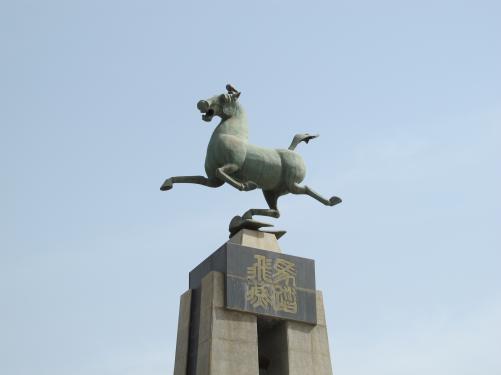
Flying horses all over the city
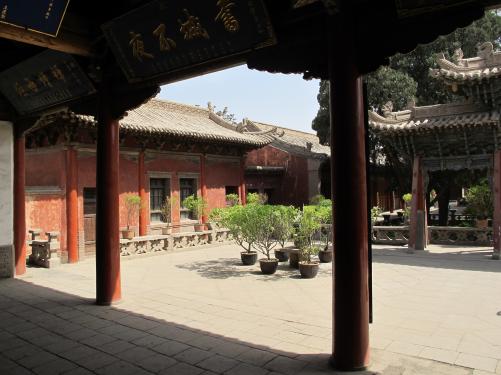
Inside the Confucius temple of Wuwei
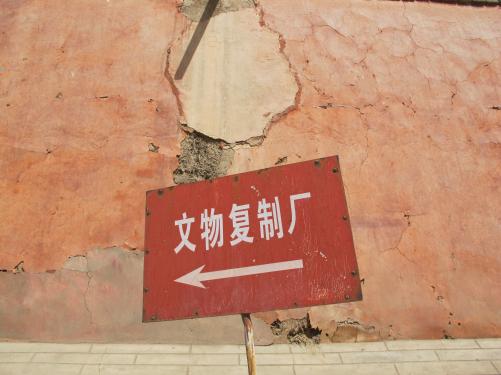
"Workshop for copying ancient cultural relics"
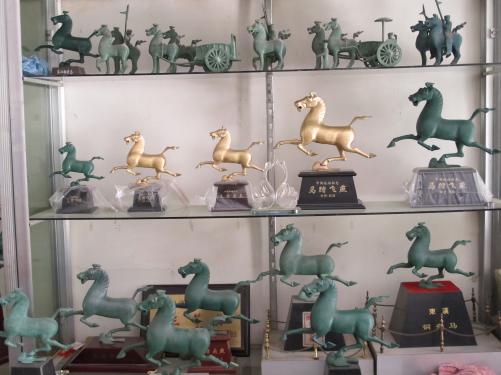
Celestial horses for everyone...
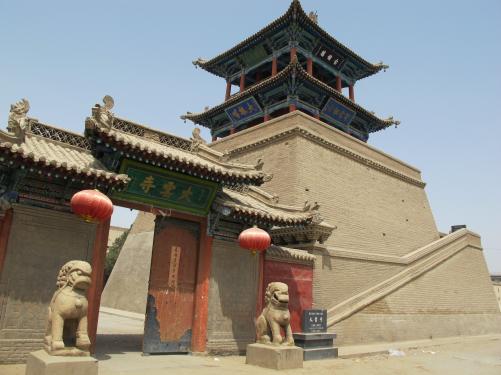
Dayun Si - Temple of the Great Cloud
Whenever I enter a hotel in these remote areas, I am very often rejected. The people behind the reception desk ususally feel a little embarrassed about this, having to tell me that foreigners are not allowed in their hotel. However, rule is rule, so I don't have another chance but to leave and find something else. Sometimes it is easier though when somebody Chinese accompanies you - places which seem to be closed for foreigners all in a sudden become accessible. So I was very happy about the company of my Chinese colleague for a couple of days.
People are sometimes astonished when I tell them about the places I am going to. What do you want to do in Wuwei? Nobody comes here...there is a museum? Really? I never went there...Well, strange foreigners!
Wuwei, known as Liangzhou in history, had been an important place in China for a long time. People started settling in this region about 5000 years ago. In 121 BC the Han emperor Wudi brought his cavalry to Wuwei, the eastern terminus of the Hexi Corridor, to defend his empire against the northern barbarians. He managed to expand the corridor westwards. When the city developed into one of the important crossroads on the Silk Road, more and more people came for settling in this area – people from all over Central Asia brought their culture and ideas to China.
Taking all this into consideration, it comes as no surprise that this city also has a museum...and I had planned to visit it. One of the most important archaeological finds all over China is the bronze figure of a galloping horse, sometimes also called the flying or celestial horse and now the logo for China tourism. This figure was excavated from a Han dynasty tomb in the city of Wuwei. Many other exmples of horses were found here, all of them giving eveidence for the fondness of emperor Wudi for horses, expecially those from the Ferghana Valley. [For all those who are interested in some more information on emperor Wudi of Han dynasty, the first envoy to Central Asia and the blood-sweating horses from Ferghane, you can check out this short text: http://www.silk-road.com/artl/wuti.shtml]
Most of the archaeological finds are now housed in the provincial museum in Lanzhou, but still some of them can be seen in the city museum of Wuwei, located in the local Confucius temple.

Flying horses all over the city

Inside the Confucius temple of Wuwei

"Workshop for copying ancient cultural relics"

Celestial horses for everyone...

Dayun Si - Temple of the Great Cloud
